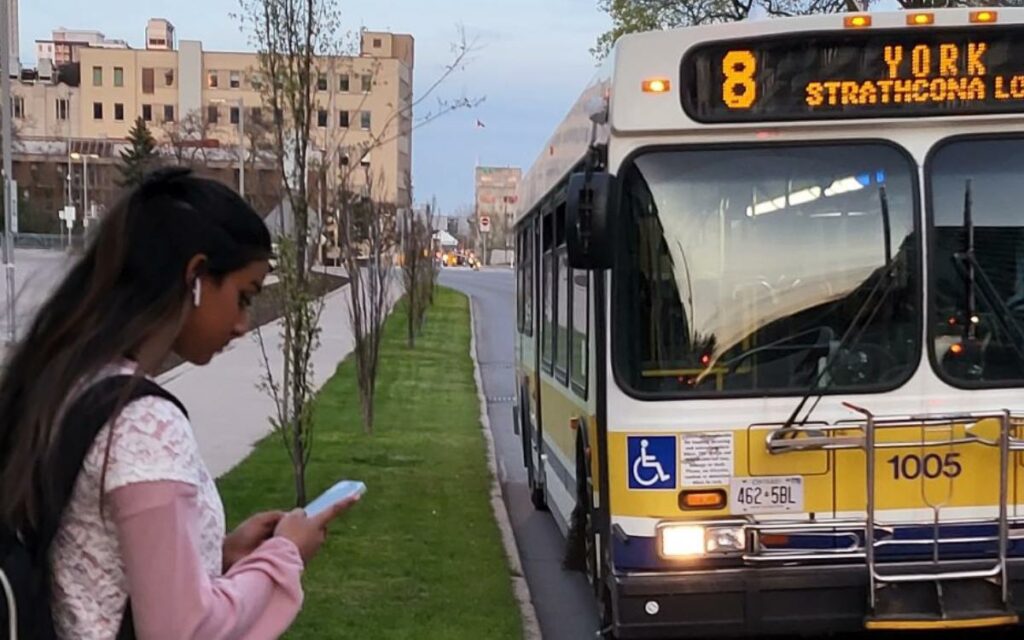
The city tied for second amongst its peers. No area scored in the A range. Photo credit: Facebook/HSR
The Toronto Region Board of Trade released a new report grading area transit service. The report analyzes 11 cities/regions including the City of Hamilton.
Of the grades awarded, Hamilton was tied with Waterloo as the second-highest-ranked transit service with a B-minus grade.
More specifically, transit service in the City of Hamilton received a percentage grade of 61 per cent.
Toronto and Mississauga topped the 11 regions with B grades.
No region was considered good enough to receive an A-plus, A, A-minus, or B-plus based on the criteria examined, painting a somewhat bleak picture of transit service in the area.
The report was written by Jonathan English, who has a PhD in Urban Planning from New York’s Columbia University.
Key Findings for City of Hamilton
Key findings for the City of Hamilton include that only 38 per cent of residents and 46 per cent of jobs are within walking distance of a route that runs every 15 minutes all day.
However, 79 per cent of residents and 73 per cent of jobs have close access to “base service.”
The report notes that travel times for many journeys are long, “especially if they are ultimately destined for other parts of the region.”
On the positive side of things, it is noted that an LRT system will soon be coming to the city and that upgraded GO service has “significantly improved access to the city from other parts of the region.”
But major shortcomings identified in regard to GO service are that West Harbour GO “has relatively poor access from the rest of the city” and that Hamilton International Airport “has no rapid connection to a GO station.”
It notes that “shuttle service” from the Hamilton International Airport to a local GO station “could greatly enhance access for travellers from all parts of the region and support its role as a regional reliever airport.”
The report also advocates for 24-hour transit service on certain routes in order to help shift workers get to their jobs.
Also flagged in the document are regional transit statistics from 2019.
Hamilton numbers show 21,659,817 rides taken in 2019 with an average of about 41 rides per capita.
The document also says that only 47 per cent of public transit operating costs in Hamilton are recouped by fares.
In comparison, 66 per cent of transit operating costs in Toronto are covered by fares, but only 29 per cent of costs in Burlington are recouped.
Although service in Hamilton has experienced 17.18 per cent growth between 2010 and 2019, ridership reportedly decreased by 7.87 per cent in that same time frame.
In similar news, The Hamilton Spectator recently reported that HSR ridership is “rebounding” from the pandemic.
As of June 2023, ridership was at 94 per cent of pre-pandemic levels (compared to June 2019).
However, it should be noted that the City of Hamilton has also seen population growth since 2019 which likely inflates ridership recovery percentages.
It remains to be seen if the upcoming LRT project, combined with HSR and GO service improvements, will lead to increased ridership levels going forward.

Based in Hamilton, he reaches hundreds of thousands of people monthly on Facebook, Instagram, TikTok, and Twitter. He has been published in The Hamilton Spectator, Stoney Creek News, and Bay Observer. He has also been a segment host with Cable 14 Hamilton. In 2017, he received the Chancellor Full Tuition Scholarship from the University of Ottawa (BA, 2022). He has also received the Governor General’s Academic Medal. He formerly worked in a non-partisan role on Parliament Hill in Ottawa.






